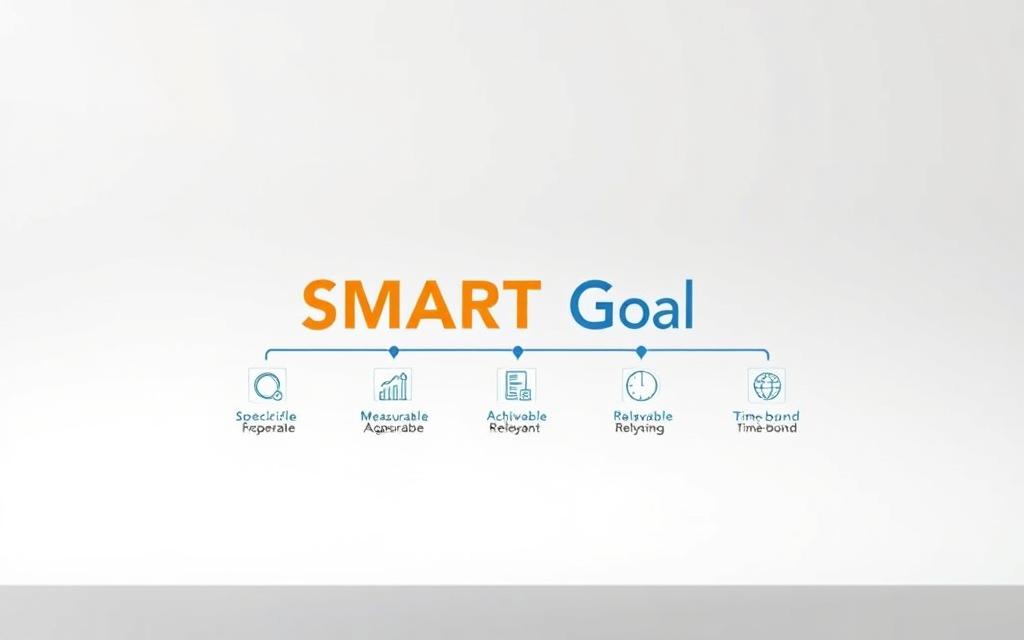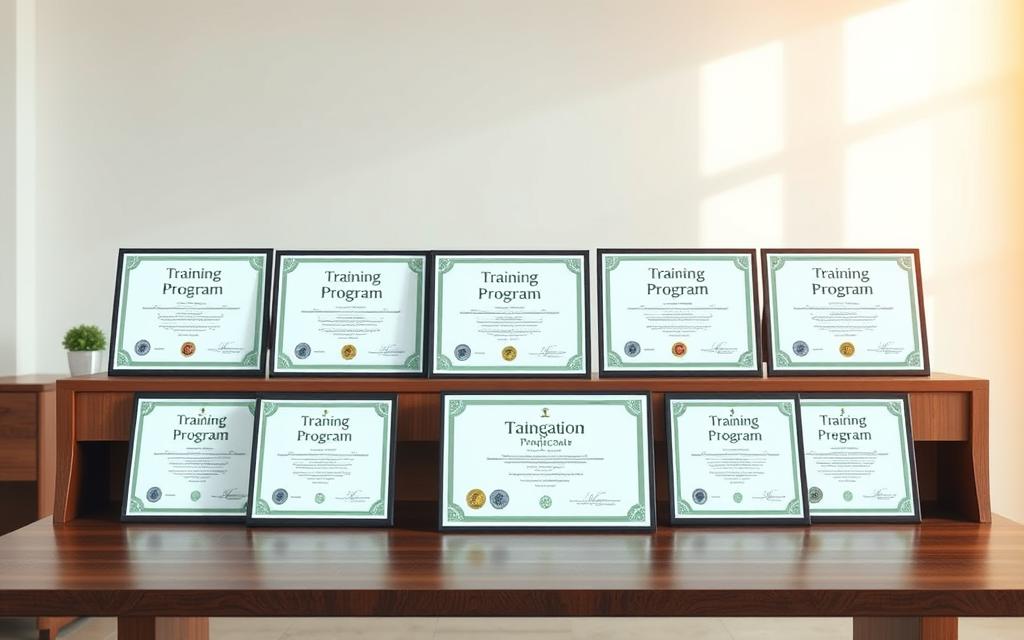Setting clear objectives for your career path can transform how you approach daily tasks and long-term ambitions. Whether aiming for a leadership role or refining technical abilities, well-defined targets create focus and momentum. Studies show employees with structured plans report higher job satisfaction and adaptability in fast-changing industries.
The SMART framework—specific, measurable, achievable, relevant, and time-bound—helps turn vague ideas into actionable steps. Companies like Microsoft and IBM use this method to align team efforts with organizational priorities. Platforms like Coursera offer certifications that support skill-building in areas from data analysis to public speaking.
Continuous learning remains vital in today’s workplace. Networking events and training programs provide opportunities to stay ahead of industry trends. For example, Google’s internal workshops emphasize collaborative problem-solving and creative thinking. Balancing these efforts with personal well-being ensures sustainable progress without burnout.
Regular feedback from mentors or peers keeps goals realistic while celebrating small wins maintains motivation. By viewing challenges as growth opportunities, you’ll build resilience and open doors to new roles. Remember, every step forward—no matter how small—shapes your professional journey.
Understanding the Importance of Professional Development Goals
In a world where industries evolve faster than ever, having a roadmap for your career isn’t just helpful—it’s essential. Clear objectives act like a compass, helping you navigate new skills, roles, and industry trends. Research from Harvard’s Division of Continuing Education shows structured plans boost confidence and adaptability, especially in tech-driven fields.
Benefits for Career Growth
Well-crafted targets create momentum. They turn abstract ideas into steps you can track, like finishing a certification or leading a project. Employees who set these markers often report higher job satisfaction and engagement—they know exactly where they’re headed.
Short-term wins matter too. For example, mastering a new software tool within three months can lead to immediate project opportunities. But long-term aims, like moving into management, build lasting value. Both types work together: quick achievements fuel motivation, while bigger visions shape your trajectory.
Short-Term vs. Long-Term Impact
Imagine a graphic designer learning UX principles (short-term) to eventually transition into a creative director role (long-term). The first goal sharpens current abilities; the second opens doors to leadership. Balancing both keeps your learning relevant and aligned with personal aspirations.
Regular check-ins with mentors or peers help adjust priorities as industries shift. This flexibility ensures your efforts stay connected to real-world demands—and your own definition of success.
How to Set Professional Development Goals
Creating a roadmap for career advancement starts with breaking big dreams into manageable steps. Whether aiming to master new tools or prepare for leadership roles, structured planning turns aspirations into results. Let’s explore proven methods to design objectives that stick.

Utilizing the SMART Framework
The SMART method transforms vague ideas into clear targets. Specific goals answer the “what” and “why”—like “Improve client communication by completing a LinkedIn Learning course.” Measurable milestones track progress, such as delivering three team presentations monthly.
Ensure objectives are achievable with current resources. A junior developer might aim to learn Python basics in six weeks rather than becoming an expert overnight. Relevance ties goals to broader career aims—a teacher studying AI tools aligns with tech-driven education trends. Finally, set deadlines (“Launch a freelance portfolio by Q3”) to maintain momentum.
Aligning Goals with Your Career Vision
Ask: “Where do I want to be in five years?” A marketing coordinator might target a director role by enhancing data analysis skills through Google Analytics courses. Regularly review job descriptions in your field to spot in-demand abilities like project management or cross-team collaboration.
Adjust plans as industries evolve. If feedback reveals gaps in public speaking, add Toastmasters sessions to your schedule. Celebrate milestones—finishing a certification or mentoring a colleague—to stay motivated. Platforms like Skillshare offer bite-sized classes to balance learning with daily tasks.
Building and Enhancing Essential Skills
Mastering the right mix of abilities can make or break your career trajectory. While technical expertise gets your foot in the door, workplace skills determine how far you’ll climb. Let’s explore how balancing these areas creates lasting growth in any field.

Technical vs. Workplace Skills
Technical skills are job-specific tools like coding or data analysis. Think Python for developers or MRI interpretation for radiologists. These measurable abilities often appear in job descriptions and certifications.
Workplace skills—like communication and conflict resolution—shape how you collaborate. A LinkedIn report found 92% of hiring managers prioritize soft skills over technical knowledge. For example, a project manager needs Excel proficiency (technical) but also requires team coordination (workplace) to meet deadlines.
Leveraging Continuous Learning
Industries evolve fast. Upskilling through platforms like Coursera or workshops keeps you competitive. High-income abilities like UX design or cloud computing certifications open doors to leadership roles.
Try this approach: audit your strengths quarterly using free online assessments. Pair this with mentorship from experienced colleagues. Apply new knowledge immediately—volunteer for cross-departmental projects or present findings at team meetings. Real-world practice turns theory into muscle memory.
Expanding Your Professional Network
Your connections often determine your career trajectory as much as your qualifications. Building relationships opens doors to unadvertised roles, collaborative projects, and fresh industry insights. A LinkedIn study found 85% of jobs are filled through networking—proving that who you know still matters in a digital-first world.

In-Person and Virtual Networking Events
Industry conferences like SXSW or virtual summits hosted on Hopin offer unique chances to meet innovators. Face-to-face chats at coffee breaks build trust faster, while online Q&A sessions let you connect with global experts without travel costs. Both formats help you spot trends before they hit mainstream media.
Set a monthly goal: attend two events minimum. Local Chamber of Commerce mixers work for regional contacts. For niche fields, platforms like Eventbrite list specialized webinars. Always prepare questions in advance—it turns small talk into meaningful exchanges.
Strategies for Utilizing Online Communities
LinkedIn Groups and Facebook communities like “Digital Marketing Questions” let you share expertise casually. Commenting on posts with actionable tips positions you as a resource. Follow hashtags like #CareerGrowth to discover thought leaders in your field.
Join five active groups related to your aspirations. Share case studies or ask for feedback on challenges—this sparks conversations that could lead to mentorship or partnerships. Remember, consistent engagement beats sporadic appearances. A quick “congrats on the promotion” message keeps relationships warm between interactions.
Developing Leadership and Communication Skills
Strong leadership and clear communication form the backbone of successful career advancement. These abilities help teams stay aligned, resolve conflicts, and drive projects forward. Research shows managers who communicate effectively see 47% higher employee engagement—a key factor in organizational success.

Cultivating Effective Communication
Great leaders know listening matters as much as speaking. Practice active listening by summarizing others’ points before responding. For example, “If I understand correctly, you’re suggesting…” builds trust and clarity.
Nonverbal cues like eye contact and posture also shape messages. Record mock presentations to spot habits like crossed arms or filler words. Pair this with effective self-assurance boost methods to project confidence during high-stakes conversations.
Opportunities for Leadership in the Workplace
Volunteer to lead small initiatives first—like organizing a training session or mentoring new hires. These low-risk roles build decision-making muscles. Companies like Adobe credit “innovation challenges” for identifying future managers through hands-on problem-solving.
Seek feedback after every leadership opportunity. Ask peers: “What worked well? What could I improve?” Mentorship programs accelerate growth by pairing you with experienced leaders who’ve navigated similar paths. Regular check-ins turn abstract advice into actionable steps.
Leveraging Training Programs and Certifications
Certifications act as career accelerators, validating your expertise to employers while expanding your skill set. Platforms like Coursera and LinkedIn Learning offer courses designed with industry leaders—think Google’s IT Certificate or AWS Cloud Practitioner training. These credentials bridge the gap between classroom theory and real-world demands.

Choosing Courses that Fit Your Goals
Start by auditing your current abilities. Ask: “What skills appear in job postings I want?” If aiming for project management roles, PMP certification could be key. For data analysts, Tableau or Power BI courses add immediate value to résumés.
Prioritize programs offering hands-on projects. Adobe’s design certifications, for example, include portfolio-building exercises employers actually review. Check completion rates and alumni reviews—Udemy’s rating system helps filter quality content.
Short-term wins matter. A weekend SEO workshop might boost your marketing campaigns next quarter. Long-term picks, like Six Sigma training, position you for leadership in manufacturing or operations. Balance both to stay adaptable as industries shift.
Remember: Relevance beats quantity. One targeted certification often outweighs five generic ones. Research emerging trends in your field—AI ethics or sustainability management—to future-proof your learning investments.
Shadowing Departments and Seeking Mentorship
Learning from colleagues in different roles reveals how workplace success relies on collaboration. Observing diverse teams helps you connect daily tasks to bigger-picture outcomes while uncovering hidden growth opportunities. This approach builds bridges between departments and sparks creative problem-solving.

Why Cross-Team Exposure Matters
Shadowing finance or product teams for a week shows how decisions ripple across departments. A marketing specialist might discover how customer feedback shapes engineering priorities. These insights help you anticipate challenges and propose solutions that benefit multiple groups.
Cross-department interactions often spark innovative ideas. For example, Amazon credits its “two-pizza teams” philosophy—small groups collaborating across functions—for faster decision-making. You’ll gain empathy for colleagues’ workflows while spotting skills to add to your toolkit.
Building Mentor Relationships That Last
Great mentors offer more than advice—they share hard-won lessons about navigating your field. Start by identifying leaders whose career paths align with your aspirations. Internal managers can explain company culture, while external mentors provide industry-wide perspectives.
Approach potential guides with specific requests. Try: “I admire how you handled the rebranding project—could we discuss your strategy over coffee?” Set clear expectations upfront, like monthly check-ins or feedback on portfolio pieces. Platforms like ADPList connect professionals with mentors in tech and design for free sessions.
Remember, mentorship works both ways. Share your fresh perspectives on emerging trends—it keeps conversations valuable for both parties. Over time, these relationships become cornerstones of sustained career momentum.
Overcoming Challenges and Embracing Opportunities
Every career path has its share of roadblocks—from shifting priorities to skill gaps. What separates thriving professionals isn’t avoiding obstacles but learning to navigate them with grit and creativity. A Salesforce survey found 68% of employees feel workplace challenges accelerate growth when approached strategically.
Strategies for Tackling Workplace Obstacles
Common hurdles like tight deadlines or miscommunication can stall progress if left unaddressed. Try these approaches:
- Reframe problems as puzzles: Break complex issues into smaller tasks. A project manager overwhelmed by scope creep might create a visual timeline using Trello
- Seek diverse perspectives: Consult colleagues in different roles. Marketing teams often solve campaign bottlenecks by collaborating with data analysts
- Implement weekly self-reviews: Ask, “What worked? What needs adjustment?” Apps like Friday.app streamline reflection without eating into busy schedules
Feedback loops turn setbacks into stepping stones. After a client presentation fell flat, one UX designer recorded practice sessions and shared them with mentors. Their tips on pacing and storytelling led to a 40% improvement in stakeholder approval rates.
Maintaining momentum during tough phases often hinges on mindset. Celebrate micro-wins—completing a certification module or resolving a team conflict. These moments build resilience while keeping long-term aspirations in sight.
Investing in Continuous Career Growth
Your career journey thrives when you treat growth as a living process, not a checklist. Regular self-assessment and openness to feedback create momentum that outlasts temporary achievements. This approach helps you adapt to industry shifts while staying true to personal values.
Implementing Self-Reflection and Feedback
Set aside 15 minutes weekly to review accomplishments and roadblocks. Ask: “What patterns emerge in my successes? Where do I consistently struggle?” Apps like Notion or Trello help visualize progress through customizable dashboards that track skill milestones.
Constructive criticism transforms blind spots into breakthroughs. A marketing specialist might discover through peer reviews that data storytelling strengthens their campaigns. Positive reinforcement techniques make integrating feedback feel empowering rather than daunting.
Try these strategies every quarter:
- Compare current abilities to industry benchmarks using LinkedIn Skill Assessments
- Schedule “growth chats” with mentors to discuss evolving aspirations
- Rewire habits with micro-changes—replace 30 minutes of social scrolling with Coursera’s structured career planning courses
Annual career audits reveal whether daily efforts align with long-term visions. A software engineer might realize their passion lies in UX design—prompting a pivot into hybrid roles. These check-ins prevent stagnation while celebrating how far you’ve come.
Conclusion
Taking charge of your career path starts with clarity and commitment. Structured roadmaps, like those outlined in a professional development plan, turn aspirations into achievable steps. By blending SMART strategies with continuous learning, you create momentum that adapts to industry shifts while fueling personal growth.
Building expertise through certifications or cross-department collaboration opens doors to unexpected roles. Networking and mentorship add fresh perspectives, helping you navigate challenges with resilience. Remember, progress isn’t about perfection—celebrate small wins like completing a course or leading a team meeting.
Stay curious. Regularly revisit your plan to align with evolving priorities, whether mastering new tools or balancing leadership opportunities. Every choice to learn, connect, or pivot shapes your journey. Start today—your future self will thank you for the investment.
